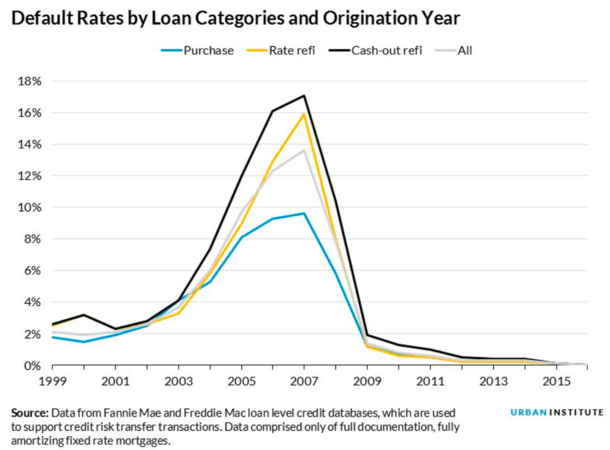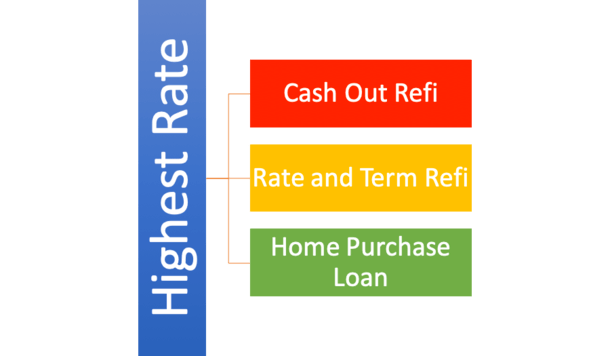Why Are Refinance Rates Higher? It All Has to Do With Risk
Mortgage
Q&A:
“Why
are
refinance
rates
higher?”
If
you’ve
been
comparing
mortgage
rates
lately
in
an
effort
to
save
some
money
on
your
home
loan,
you
may
have
noticed
that
refinance
rates
are
higher
than
purchase
loan
rates.
This
seems
to
be
the
case
for
a
lot
of
big
banks
out
there,
including
Chase,
Citi,
and
Wells
Fargo,
which
while
enormous
institutions,
aren’t
necessarily
the
leaders
in
the
mortgage
biz
anymore.
In
fact,
today
United
Wholesale
Mortgage
in
the
#1
spot,
followed
by
Rocket
Mortgage,
then
a
mix
of
these
big
banks
and
nonbanks,
including
CrossCountry
Mortgage,
Fairway
Independent
Mortgage,
and
others.
So
why
is
that
some
of
the
big
guys
list
“purchase
rates”
and
“refinance
rates”
separately,
with
different
pricing,
points,
and
APRs?
Well,
for
starters
a
home
purchase
is
not
the
same
as
a
mortgage
refinance,
despite
both
processes
being
very
similar,
and
the
underlying
loans
themselves
not
much
different.
Ultimately,
a
home
purchase
loan
is
for
someone
who
has
yet
to
buy
a
property,
whereas
a
mortgage
refinance
is
for
an
existing
homeowner
who
wants
to
redo
their
home
loan.
We
know
they
are
different
objectives,
but
if
the
underlying
loans
are
both
30-year
fixed
mortgages
with
the
same
loan
amounts,
the
same
borrower
credit
scores,
and
the
same
property
types,
why
should
rates
be
any
different?
Let’s
find
out.
Home
Purchase
Mortgages
Default
the
Least

There
are
three
main
types
of
mortgages,
including
home
purchase
loans,
rate
and
term
refinances,
and
cash
out
refinances.
The
first
is
self-explanatory
and
was
already
explained
above,
the
second
is
simply
redoing
your
existing
mortgage
by
obtaining
a
new
interest
rate
and
loan
term,
without
changing
the
loan
amount.
The
third
type
results
in
a
larger
loan
amount
at
closing
because
you’re
pulling
equity
from
your
home,
which
a
layman
should
assume
would
be
the
riskiest
transaction.
After
all,
if
a
borrower
owes
more
debt
as
a
result,
and
maybe
even
has
a
higher
monthly
mortgage
payment,
their
hypothetical
default
risk
should
rise.
Simply
put,
when
you
pull
cash
out
of
your
home,
you
increase
your
outstanding
loan
balance,
increase
your
loan-to-value
ratio
(LTV),
and
reduce
your
available
home
equity.
That’s
inherently
riskier,
and
explains
why
there
are
specific
mortgage
pricing
adjustments
for
such
loans.
This
in
theory
should
result
in
a
higher
mortgage
rate
to
compensate
for
increased
risk.
And
guess
what
–
that
is
indeed
the
case!
Cash
out
refinance
rates
are
the
highest,
all
else
being
equal,
for
basically
all
banks
and
lenders.
At
least
something
makes
sense
around
here…
A
Rate
and
Term
Refinance
Sounds
the
Least
Risky,
Doesn’t
It?

Now,
a
rate
and
term
refinance
should
result
in
the
least
amount
of
default
risk
because
the
borrower
is
likely
reducing
their
monthly
payment
in
the
process.
That’s
generally
the
reason
to
refinance
in
the
first
place.
This
happens
via
a
lower
interest
rate
and
possibly
a
lower
outstanding
balance
(paid
down
since
origination)
spread
out
over
a
brand-new
loan
term.
That
leaves
us
with
home
purchase
loans,
which
you’d
think
would
be
less
risky
than
a
cash
out
refinance,
but
not
as
risky
as
a
rate
and
term
refinance,
since
it’s
ostensibly
a
first-time
home
buyer
or
someone
in
a
new
property.
If
you
were
the
bank,
you’d
probably
want
to
give
a
new,
cheaper
loan
to
the
seasoned
homeowner
who
has
been
paying
their
mortgage
for
years
as
opposed
to
the
first-time
buyer
or
even
a
move-up
buyer
taking
on
more
debt.
But
for
one
reason
or
another,
some
banks
and
mortgage
lenders
offer
the
lowest
mortgage
rates
on
home
purchase
transactions.
The
Lowest
Mortgage
Rates
Are
Offered
on
Home
Purchase
Loans
The
reason
boils
down
to
DATA.
Despite
the
fact
that
the
actual
loan
characteristics
(such
as
FICO
score,
LTV,
and
DTI)
would
indicate
the
lowest
default
rates
on
rate
and
term
refinances,
it
is
purchase
loans
that
perform
the
best.
One
possible
reason
why
is
because
of
faulty
appraisals
on
refinances,
which
perhaps
overvalue
properties.
Regardless,
purchase
mortgages
default
the
least,
followed
by
rate
and
term
refinances,
and
finally
cash
out
refinances,
the
last
of
which
actually
makes
sense.
Interestingly,
the
loan
characteristics
also
indicate
that
cash
out
refis
and
purchase
mortgages
should
default
at
about
the
same
rate,
yet
they
are
priced
the
furthest
apart.
And
again,
that’s
because
in
real
life,
not
expected
default
rates,
purchase
loans
default
the
least
and
cash
out
refis
default
the
most.
Lowest:
Home
purchase
rates
Slightly
Higher:
Rate
and
term
refinance
rates
Highest:
Cash
out
refinance
rates
So
when
you
compare
mortgage
lenders,
you
often
might
find
that
purchase
rates
are
the
cheapest,
followed
by
rate
and
term
refi
rates,
and
finally
cash
out
mortgage
rates.
There’s
no
question
cash
out
refinances
cost
the
most
–
this
is
the
norm
amongst
all
banks
and
lenders
to
my
knowledge.
But
not
all
banks/lenders
offer
different
rates
for
purchases
and
rate
and
term
refis.
Sometimes
they’re
just
priced
exactly
the
same.
How
Much
More
Expensive
Are
Refinance
Rates?
-
Big
banks
tend
to
advertise
higher
refinance
rates
vs.
purchase
rates -
Some
lenders
don’t
differentiate
between
purchase
rates
and
rate
and
term
refi
rates -
Or
simply
charge
slightly
higher
closing
costs
on
refinance
transactions -
Rates
may
be
.25%
to
.375%
higher
on
refis
but
pay
attention
to
points
charged
and
loan
assumptions
I
looked
around
and
found
that
Chase,
Citi,
and
Wells
Fargo
offer
lower
home
purchase
rates,
while
Quicken
Loans
offers
the
same
exact
rates
for
purchases
and
rate
and
term
refis.
Quicken
even
says
this
in
their
fine
print:
“Based
on
the
purchase/refinance
of
a
primary
residence
with
no
cash
out
at
closing.”
In
other
words,
a
purchase
and
rate
and
term
refi
are
priced
the
same.
Clearly
this
matters
when
shopping
around
for
a
mortgage,
so
take
notice
of
who
is
charging
more/less
for
certain
transaction
types
and
choose
accordingly
based
on
what
you’re
looking
for.
The
same
might
be
true
of
an
FHA
loan
vs.
conventional
loan.
Depending
on
what
you
need,
one
lender
may
offer
a
much
better
price.
One
last
thing
–
pay
attention
to
the
assumptions
lenders
make
when
they
list
their
rates.
It
could
also
be
that
you’re
not
comparing
apples
to
apples,
if
there
are
different
loan
amounts,
LTVs,
credit
scores,
mortgage
points,
and
so
on.
But
know
refinance
rates
are
higher
because
they
default
more
than
purchase
loans,
and
that
requires
a
higher
price
to
compensate
for
heightened
risk,
plain
and
simple.
Comments are closed.